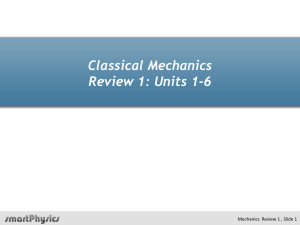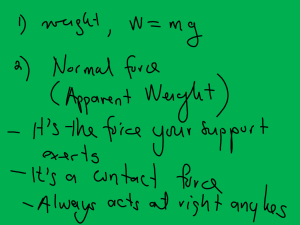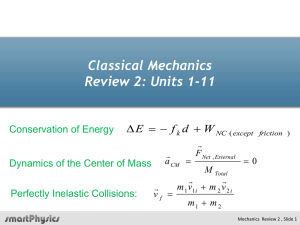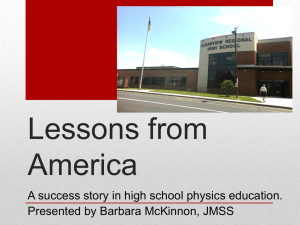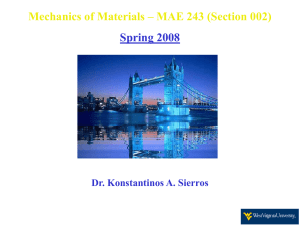Review for Final Exam
advertisement
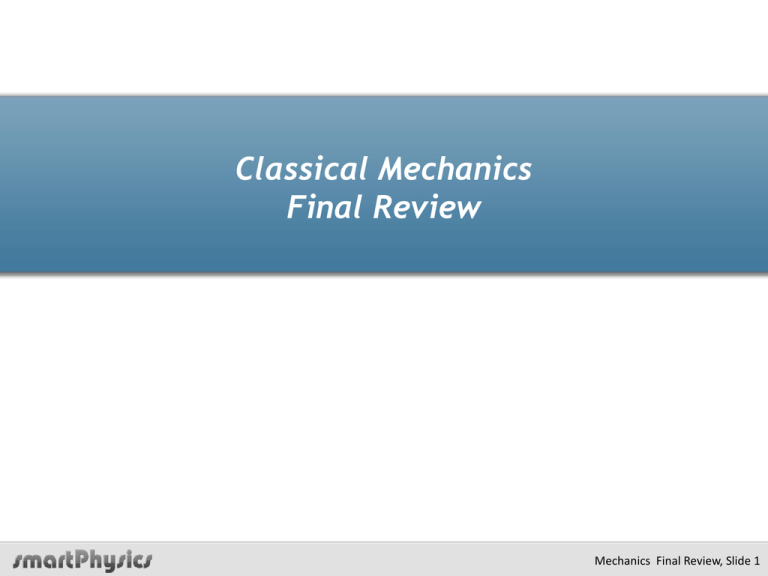
Classical Mechanics Final Review Mechanics Final Review, Slide 1 Important Equations Fnet net d Ptot dt d L tot DYNAMICS If Fnet 0 , then Ptot constant M a cm I dt If net 0 , then L tot constant CONSERVATION OF ENERGY E K U f k d W NC LINEAR AND ROTATIONAL QUANTITIES s R , Rolling motion: v R , at R vCM = R aCM = αR Mechanics Review 3, Slide 2 Example: Three Blocks Three blocks are placed in contact on a horizontal frictionless surface. A constant force F is applied to the box of mass M. There is friction between the surfaces of blocks 2M and 3M (µs=0.26) so the three blocks accelerate together to the right. What is the acceleration of the blocks? Assume block 3M does not slide. A: 0.67 m/s2 . What is the maximum force F that can be applied, before the 3M block slides off? A: 107 N. 3M F M M=7 Kg F = 28 N Fnet m a fs s N 2M Mechanics Final Review, Slide 3 Example: Circular motion A ball of mass m swings in a vertical circle of radius R at the end of a string. The tension in the string is T when its angle from the highest point on the circle is θ. What is the ball's speed at that point? What are the magnitude and direction of the ball's acceleration at that point? F net , r ma r mv / R 2 R θ T F net , t ma t MM Me Mechanics Final Review, Slide 4 Example: Elastic Collision A 5 kg block slides on a horizontal, frictionless surface with a velocity of 2 m/s. It collides with an ideal, massless spring which is attached to a 15 kg block which is initially at rest. The spring has a spring constant of k = 50 N/m. At the instant the spring is maximally compressed: What is the common velocity of the masses? A: 0.5 m/s. How do the accelerations of the two blocks compare? A: 3:1. What is the compression of the spring? A: 0.55 m. Ptot 0 E K U sp 0 Mechanics Final Review, Slide 5 Example: Rod Attached to a Wall A uniform rod of mass M = 2 kg and length L = 1.5 m is attached to a wall with a frictionless pivot and a string as shown in the diagram above. The initial angle of the rod with respect to the wall, is = 39. The string is then cut. The moment of inertia of a rod about an axis through one end is 1/ ML2. 3 What is the angular acceleration of the rod, , immediately after the string is cut? A: = 6.17 rad/s2 g net , P I P What is the angular velocity ω of the rod when it is horizontal (θ=90)? E K R U g 0 A: ω = 3.9 rad/sec 2 U g Mg y CM K R 1 2 I P Mechanics Final Review, Slide 6 Example: Bullet and Block A 10 g bullet shot from a gun is travelling with a speed of vo = 100 m/s when it hits and embeds itself in an mA = 500 g wooden block that initially sits at rest on a horizontal, frictionless surface. The block + bullet subsequently travels up a frictionless incline with an angle of inclination θ = 20°. What is the maximum length D that the block can reach up the slope? A: 0.57 m Ptot 0 After the collision: D vo mA E K U g 0 = 20° Mechanics Final Review, Slide 7 Example: Ladder Statics A ladder of mass M = 15.0 kg and length L = 10.0 m rests against a frictionless vertical wall and on a frictionless horizontal surface. A rope is attached to the bottom of the ladder and fixed to the vertical wall at the horizontal surface. The ladder makes an angle θ = 60º with respect to the horizontal. Find the force exerted by the vertical wall on the ladder. Find the tension in the rope. F net , x 0 A: T = Nw = 42.4 N L M θ Fnet , y 0 net , P 0 Mechanics Final Review, Slide 8 Example: Double Massive Pulley The coefficient of kinetic friction between the 2.0 kg block and the table is 0.10. The moment of inertia of each pulley is I = MR2 /2, where M = 0.5 kg and R = 0.1 m. (a) What is the speed of the blocks after they have moved a distance d? (b) What are the tensions in the strings? (a) E K U g f k d (b) First find the acceleration using kinematics. Then use: Fnet m a for each block. Mechanics Final Review, Slide 9 Example: Rolling Motion A horizontal force F is applied to a lawn roller in the form of a solid cylinder of radius R and mass M and the cylinder starts rolling from rest, without slipping. The force F passes through the center of mass of the cylinder. The moment of inertia of the cylinder is Icm = MR2 /2. (a) Calculate the acceleration of the center of mass of the cylinder. (b) Calculate the force of static friction on the cylinder. (c) Calculate the minimum coefficient of friction necessary to prevent slipping. cm I cm f s R I cm F x Ma cm F f s Ma cm acm = αR fs s N Mechanics Final Review, Slide 10 Example: Block on Inclines A block of mass m is released from rest a height hi on a frictionless inclined plane that makes an angle θ with the horizontal. At the bottom of the incline, the mass encounters a horizontal surface of length L which has a coefficient of friction µk. After sliding across the horizontal surface, the mass goes up a second frictionless incline that also makes an angle θ the horizontal. Find the maximum height of the mass, hf, on the second incline. m hi hi 30 ° E g f k L µk θ L L 30° 30 ° θ Mechanics Final Review, Slide 11 Example: Raising a Wheel A wheel of mass M = 2.00 kg and radius R = 0.170 m rests on a horizontal surface against a vertical step of height h = 0.010 m. A point below the center of the wheel is a distance x = 0.0575 m from the vertical step. The wheel is to be raised over the step by a horizontal force F applied to the axle of the wheel as shown in the figure. What is the minimum force Fmin needed to raise the wheel over the step? A: 0.359 Mg net , step 0 Fmin R h x Mechanics Final Review, Slide 12 Example: Wave on a String The string is driven at a frequency of 5.00 Hz. The amplitude of the motion is A = 12.0 cm and the wave speed is v = 20.0 m/s. Set y(0,0) = 0. (a) Find the angular frequency and the wave number of the wave. (b) Find an expression for y(x,t). (c) Find the maximum transverse speed and acceleration. f 2 y A sin kx t vy dy dt A cos kx t Mechanics Final Review, Slide 13 Example: Spring System M = 8.0 kg A spring with spring constant k is suspended from the ceiling. A block of mass M hangs from the spring. A bullet of mass m is fired vertically upward into the bottom of the block, get embedded in it, and the spring's maximum compression d is measured. The block and bullet system then oscillates. Find an expression for the bullet's speed vB in terms of m, M, k and d. Find the frequency ω of the oscillation. k Find the amplitude A of the oscillation. M Ptot 0 k/M v = 12 m/s E K U g U sp 0 m = 0.5 kg After the collision: T m Mechanics Final Review, Slide 14 Example: Spring and Pulley A 2.00 kg block situated on a rough incline of 37.0o and coefficient of kinetic friction 0.160, is connected to a spring of negligible mass having a spring constant of 100 N/m. The pulley has negligible mass and is frictionless. The block is released from rest when the spring is unstretched. (a) Calculate the force of kinetic friction on the block. (b) Calculate the distance the block will move until it stops momentarily. (c) Calculate the distance at which the acceleration of the block becomes zero for the first time. E K U g U sp 0 Fnet m a Mechanics Final Review, Slide 15 Example: Pulley and two masses A pulley is made from two disks glued together with an axle at their center. The radii of the inner and outer disks are R and 3R, respectively. String is wound around the inner and outer disks, from which hang masses M1 and M2 as shown. The system is released from rest and M2 begins to fall; neither string slips. The moment of inertia of the pulley is I. What is the speed v2, of the mass M2 after it has fallen a distance d? 3R R E K U g 0 M2 d M1 Mechanics Review 3, Slide 16
